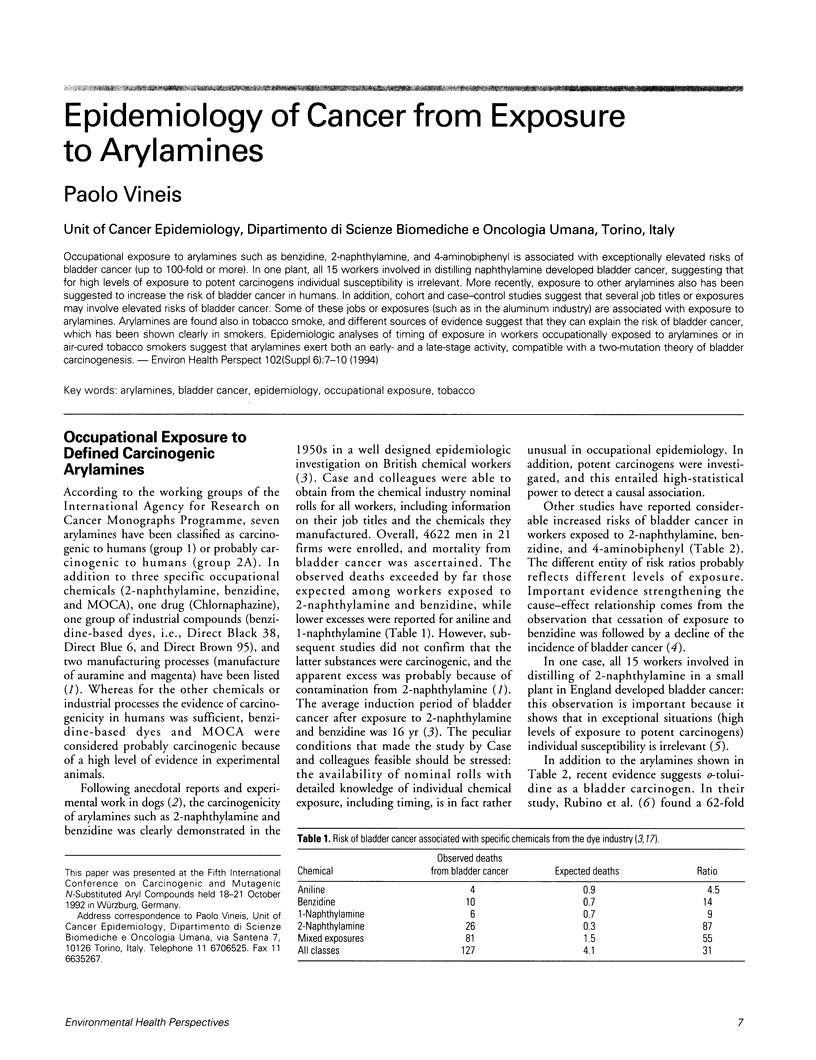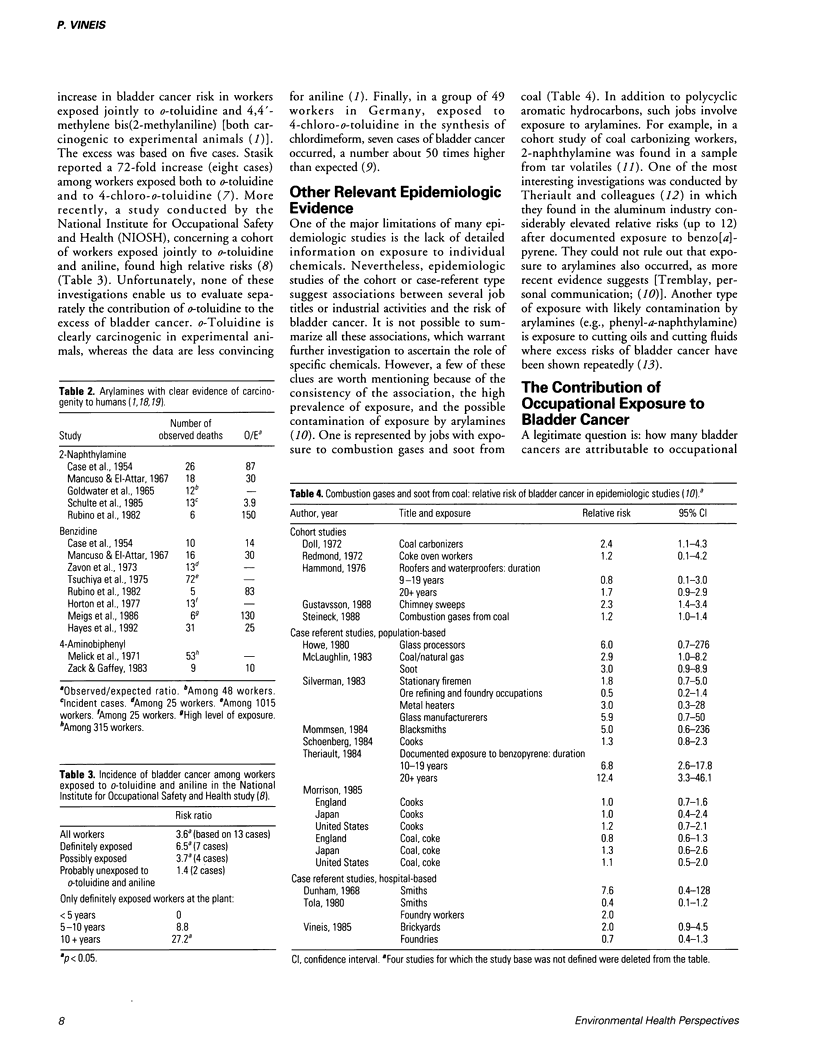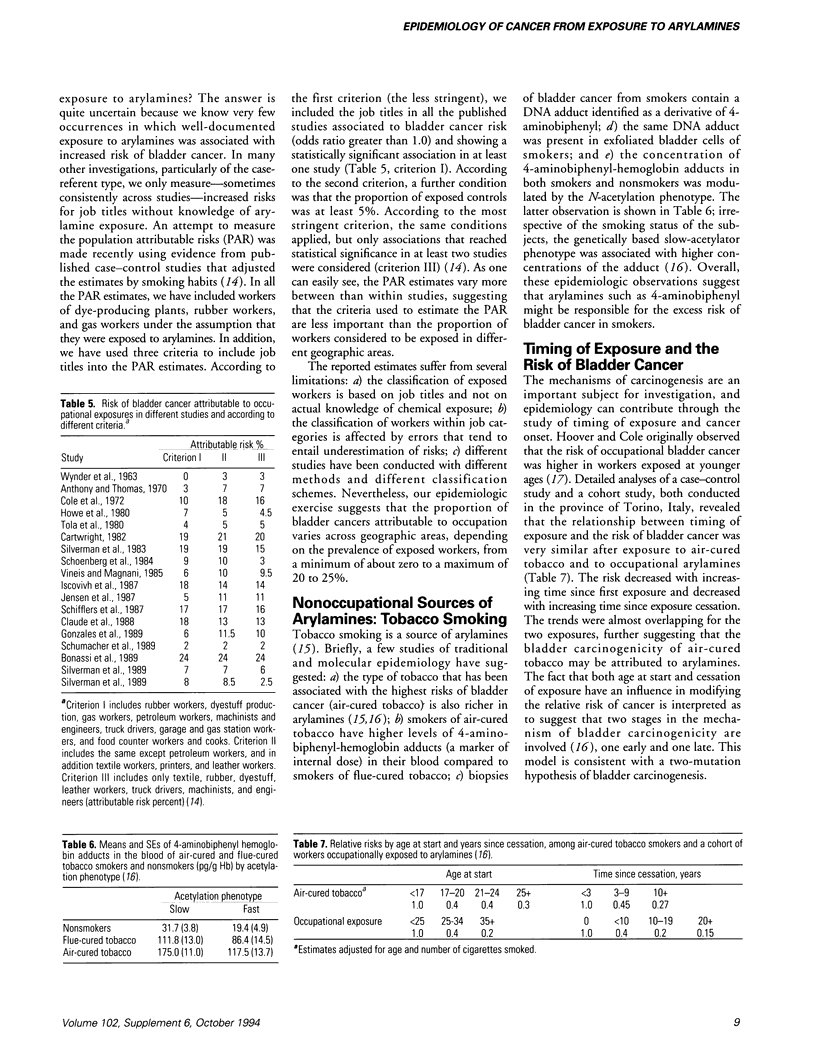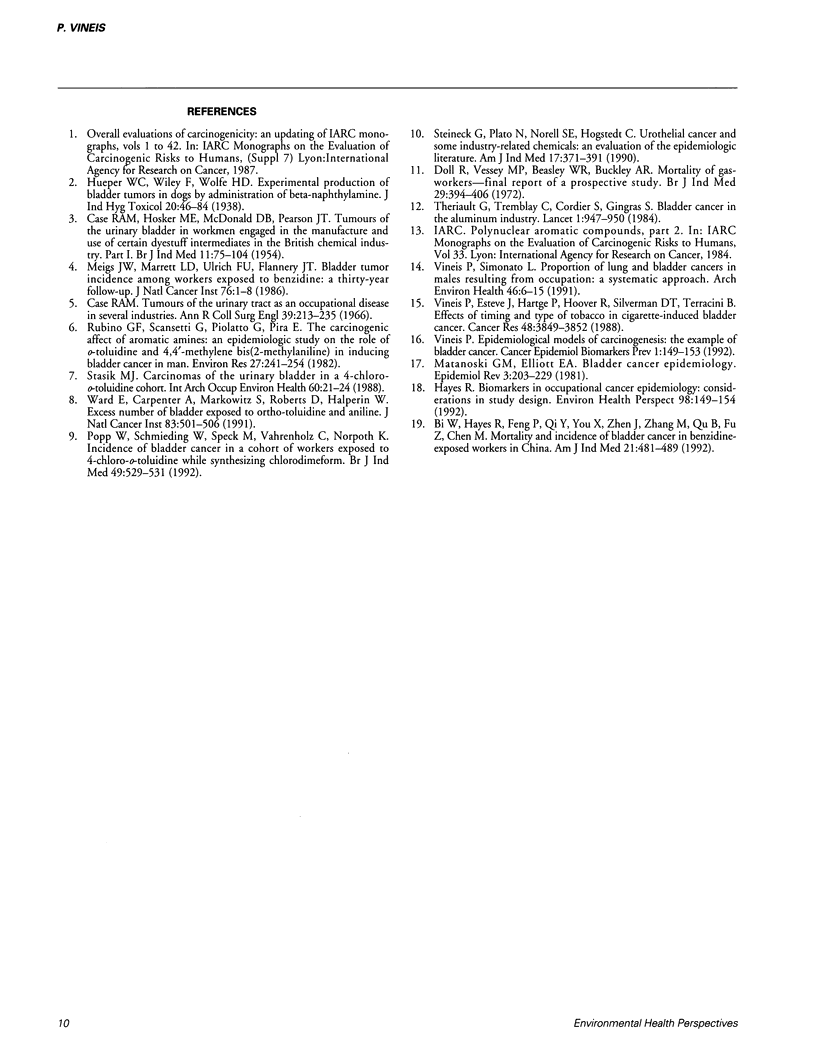Abstract
Occupational exposure to arylamines such as benzidine, 2-naphthylamine, and 4-aminobiphenyl is associated with exceptionally elevated risks of bladder cancer (up to 100-fold or more). In one plant, all 15 workers involved in distilling naphthylamine developed bladder cancer, suggesting that for high levels of exposure to potent carcinogens individual susceptibility is irrelevant. More recently, exposure to other arylamines also has been suggested to increase the risk of bladder cancer in humans. In addition, cohort and case-control studies suggest that several job titles or exposures may involve elevated risks of bladder cancer. Some of these jobs or exposures (such as in the aluminum industry) are associated with exposure to arylamines. Arylamines are found also in tobacco smoke, and different sources of evidence suggest that they can explain the risk of bladder cancer, which has been shown clearly in smokers. Epidemiologic analyses of timing of exposure in workers occupationally exposed to arylamines or in air-cured tobacco smokers suggest that arylamines exert both an early- and a late-stage activity, compatible with a two-mutation theory of bladder carcinogenesis.
Full text
PDF



Selected References
These references are in PubMed. This may not be the complete list of references from this article.
- Bi W., Hayes R. B., Feng P., Qi Y., You X., Zhen J., Zhang M., Qu B., Fu Z., Chen M. Mortality and incidence of bladder cancer in benzidine-exposed workers in China. Am J Ind Med. 1992;21(4):481–489. doi: 10.1002/ajim.4700210404. [DOI] [PubMed] [Google Scholar]
- Case R. A. Tumours of the urinary tract as an occupational disease in several industries. Ann R Coll Surg Engl. 1966 Oct;39(4):213–235. [PMC free article] [PubMed] [Google Scholar]
- Doll R., Vessey M. P., Beasley R. W., Buckley A. R., Fear E. C., Fisher R. E., Gammon E. J., Gunn W., Hughes G. O., Lee K. Mortality of gasworkers - final report of a prospective study. Br J Ind Med. 1972 Oct;29(4):394–406. doi: 10.1136/oem.29.4.394. [DOI] [PMC free article] [PubMed] [Google Scholar]
- Hayes R. B. Biomarkers in occupational cancer epidemiology: considerations in study design. Environ Health Perspect. 1992 Nov;98:149–154. doi: 10.1289/ehp.9298149. [DOI] [PMC free article] [PubMed] [Google Scholar]
- Matanoski G. M., Elliott E. A. Bladder cancer epidemiology. Epidemiol Rev. 1981;3:203–229. doi: 10.1093/oxfordjournals.epirev.a036234. [DOI] [PubMed] [Google Scholar]
- Meigs J. W., Marrett L. D., Ulrich F. U., Flannery J. T. Bladder tumor incidence among workers exposed to benzidine: a thirty-year follow-up. J Natl Cancer Inst. 1986 Jan;76(1):1–8. [PubMed] [Google Scholar]
- Popp W., Schmieding W., Speck M., Vahrenholz C., Norpoth K. Incidence of bladder cancer in a cohort of workers exposed to 4-chloro-o-toluidine while synthesising chlordimeform. Br J Ind Med. 1992 Aug;49(8):529–531. doi: 10.1136/oem.49.8.529. [DOI] [PMC free article] [PubMed] [Google Scholar]
- Rubino G. F., Scansetti G., Piolatto G., Pira E. The carcinogenic effect of aromatic amines: an epidemiological study on the role of o-toluidine and 4,4'-methylene bis (2-methylaniline) in inducing bladder cancer in man. Environ Res. 1982 Apr;27(2):241–254. doi: 10.1016/0013-9351(82)90079-2. [DOI] [PubMed] [Google Scholar]
- Stasik M. J. Carcinomas of the urinary bladder in a 4-chloro-o-toluidine cohort. Int Arch Occup Environ Health. 1988;60(1):21–24. doi: 10.1007/BF00409374. [DOI] [PubMed] [Google Scholar]
- Steineck G., Plato N., Norell S. E., Hogstedt C. Urothelial cancer and some industry-related chemicals: an evaluation of the epidemiologic literature. Am J Ind Med. 1990;17(3):371–391. doi: 10.1002/ajim.4700170310. [DOI] [PubMed] [Google Scholar]
- Thériault G., Tremblay C., Cordier S., Gingras S. Bladder cancer in the aluminium industry. Lancet. 1984 Apr 28;1(8383):947–950. doi: 10.1016/s0140-6736(84)92399-7. [DOI] [PubMed] [Google Scholar]
- Vineis P. Epidemiological models of carcinogenesis: the example of bladder cancer. Cancer Epidemiol Biomarkers Prev. 1992 Jan-Feb;1(2):149–153. [PubMed] [Google Scholar]
- Vineis P., Esteve J., Hartge P., Hoover R., Silverman D. T., Terracini B. Effects of timing and type of tobacco in cigarette-induced bladder cancer. Cancer Res. 1988 Jul 1;48(13):3849–3852. [PubMed] [Google Scholar]
- Vineis P., Simonato L. Proportion of lung and bladder cancers in males resulting from occupation: a systematic approach. Arch Environ Health. 1991 Jan-Feb;46(1):6–15. doi: 10.1080/00039896.1991.9937423. [DOI] [PubMed] [Google Scholar]
- Ward E., Carpenter A., Markowitz S., Roberts D., Halperin W. Excess number of bladder cancers in workers exposed to ortho-toluidine and aniline. J Natl Cancer Inst. 1991 Apr 3;83(7):501–506. doi: 10.1093/jnci/83.7.501. [DOI] [PubMed] [Google Scholar]


